About This Journal
Horticultural Science and Technology (abbr. Hortic. Sci. Technol., herein ‘HST’; ISSN, 1226-8763), one of the two official journals of the Korean Society for Horticultural Science (KSHS), was launched in 1998 to provide scientific and professional publication on technology and sciences of horticultural area. As an international journal, HST is published in English and Korean, bimonthly on the last day of even number months, and indexed in ‘SCIE’, ‘SCOPUS’ and ‘CABI’. The HST is devoted for the publication of technical and academic papers and review articles on such arears as cultivation physiology, protected horticulture, postharvest technology, genetics and breeding, tissue culture and biotechnology, and other related to vegetables, fruit, ornamental, and herbal plants.



-
Research Article
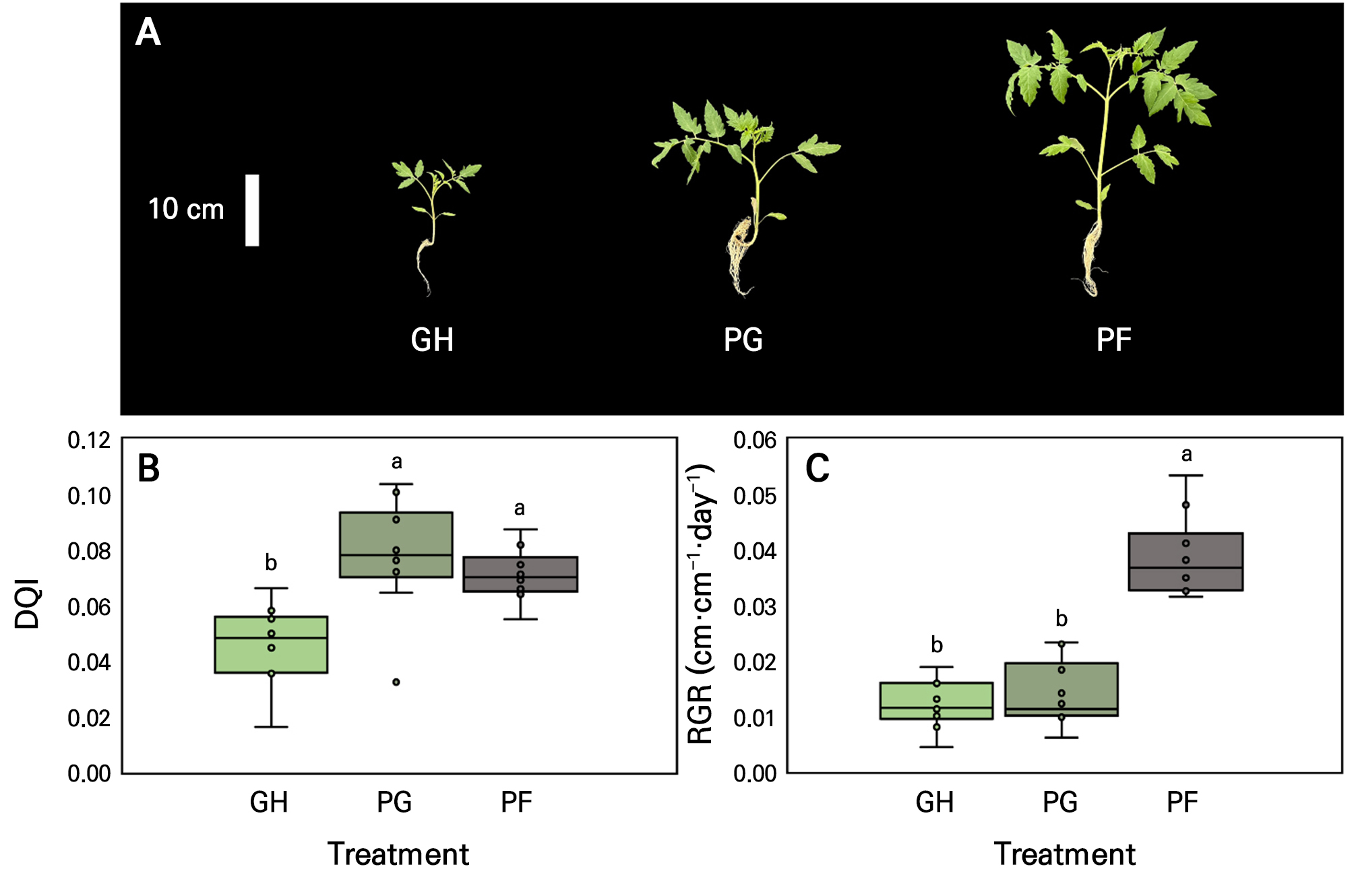
- Seedling Quality and Early Growth after the Transplanting of Tomato Seedlings Grown using Different Production Methods
- Yun Hyeong Bae, Hwi Chan Yang, Young Ho Kim, Soon Jae Hyeon, Min Seong Choi, Ngoc-Thang Vu, Dong Cheol Jang
- To assess the feasibility of using plant-factory-produced seedlings for vegetable production, this study compared the seedling quality and early growth of tomato …
- To assess the feasibility of using plant-factory-produced seedlings for vegetable production, this study compared the seedling quality and early growth of tomato seedlings grown in a nursery greenhouse (GH seedlings), serving as the control group; a plant factory and then a nursery (PG seedlings); and a plant factory (PF seedlings). Seedlings from all treatments were then transplanted in a greenhouse and all were grown together. The average daily temperatures in the plant factory and nursery greenhouse were similar, but the difference between day and night was more pronounced in the nursery greenhouse. The average daily relative humidity was higher in the plant factory. The relative growth rate was highest for the PF seedlings, but the compactness and the Dickson quality index were highest in the PG seedlings. Regarding the belowground characteristics, the number of roots was greatest in the PF seedlings, but the root surface area, average root length, and quantity of fine roots were best in the PG seedlings. In terms of chlorophyll fluorescence, the Fv/Fm ratio showed normal values ranging from 0.78 to 0.84 across all treatments. However, the Pi_Abs, ABS/RC, TRo/RC, and ETO/RC parameters indicated that the PF seedlings experienced more compared to the seedlings from the other treatments. Plant heights were significantly different among the treatments immediately after transplanting, but by week 6, differences among the treatments became insignificant for most indices. Though not treated with growth regulators, the PG seedlings exhibited robust seedling quality without overgrowth, good root establishment, and good growth trends similar to those of the GH seedlings after transplanting. Therefore, this study determined that seedlings cultivated up to the temporary planting stage in a PFAL and then cultivated in a greenhouse until transplanting exhibit excellent seedling quality, root establishment, and growth after transplanting, making them suitable for commercial seedling production. - COLLAPSE
-
Research Article

- Comparison of the Quality and Internal Physiological Disorders of ‘Wonhwang’ Pear (Pyrus pyrifolia Nakai) of Different Fruit Sizes during Shelf Life after Cold Storage
- Sung-Joon Park, Hyeong-Seok Lee, Young-Jik Ahn, Jong-Pil Chun
- This study investigated the effects of several fruit size factors on quality changes and the incidence of internal physiological disorders during the …
- This study investigated the effects of several fruit size factors on quality changes and the incidence of internal physiological disorders during the simulated export and distribution of ‘Wonhwang’ pears (Pyrus pyrifolia Nakai), the main early-season variety of Korean pear for export. Experiments were conducted on fruits packed (5 kg base) in four different grades of export standards at the Cheonan Pear Export Sorting Facility in 2023. All packaged fruits were stored at 1°C for 30 days to simulate export transportation, followed by a simulated shelf life at 25°C for 21 days. The soluble solids content did not vary by size, but the titratable acidity was lowest in the smallest fruit (Size 10) over the entire shelf lifetime. In addition, Size 10 fruits showed a higher respiration rate and greater ethylene production than fruits of other sizes. It was also found that the largest fruit (Size 7) and smallest fruit (Size 10) had lower levels of ethanol-insoluble substances than the medium-grade fruits of Sizes 8 and 9. The incidences of physiological disorders for fruits designated as Sizes 8 and 9 were lower in with regard to core browning and flesh browning compared to the largest fruit (Size 7) and smallest fruit (Size 10). Fruits of Size 8 and size 9 were judged to be the most suitable export standards for ‘Wonhwang’ pears. - COLLAPSE
-
Research Article
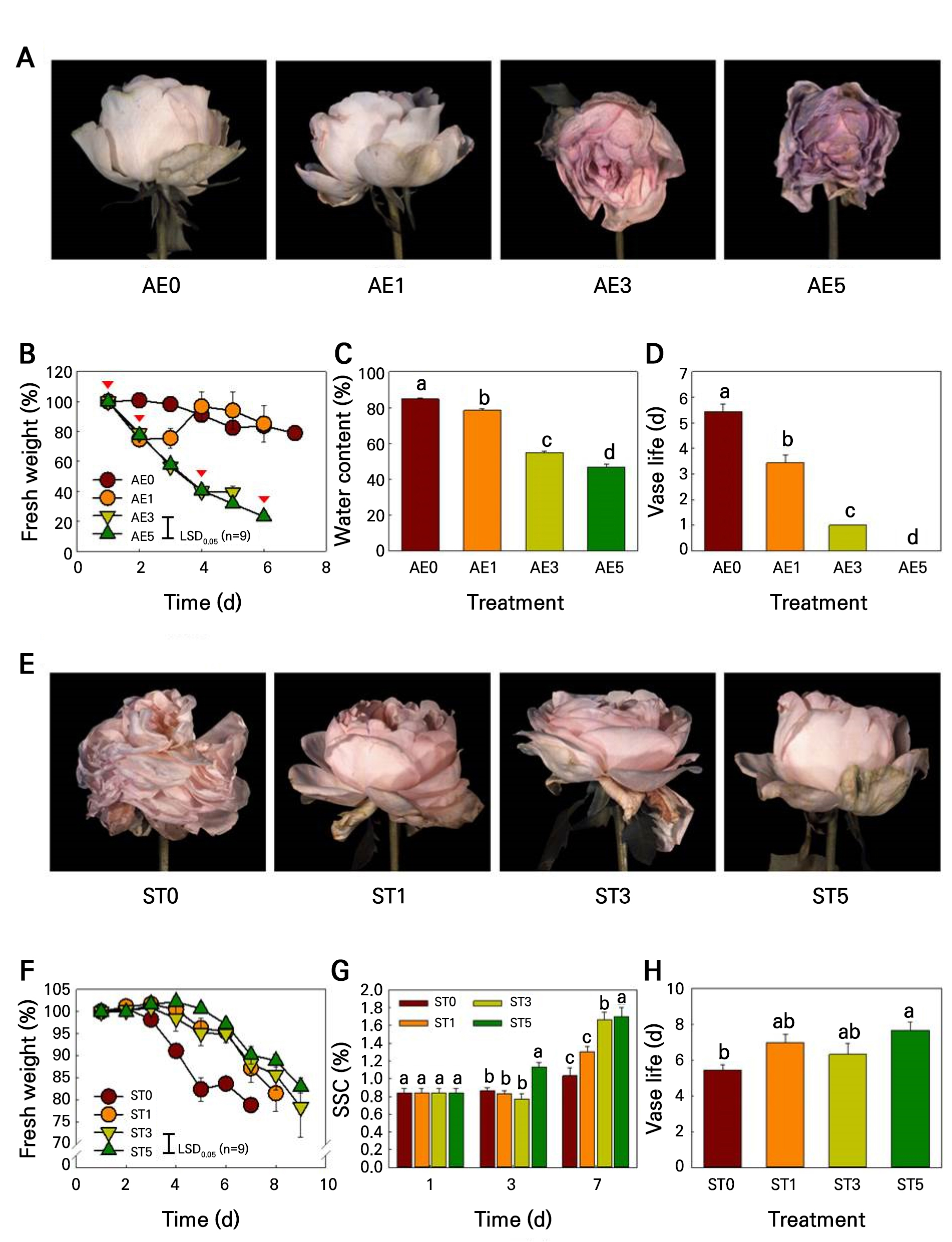
- Rapid Estimations of the Postharvest Quality and Longevity of Cut Roses using Vis/NIR Spectroscopy
- Ji Yeong Ham, Yong-Tae Kim, Suong Tuyet Thi Ha, Bongsu Choi, Byung-Chun In
- Visible and near-infrared (Vis/NIR) spectroscopy is widely used to assess plant physiological characteristics in various horticultural crops. As cut flower longevity has …
- Visible and near-infrared (Vis/NIR) spectroscopy is widely used to assess plant physiological characteristics in various horticultural crops. As cut flower longevity has become important for marketing, a rapid technique for estimating the internal quality of these products is necessary. In this study, we estimated the primary physiological factors affecting the water content and soluble solids content (SSC) using Vis/NIR spectroscopy to predict the postharvest quality and vase life of cut roses. First, cut roses were subjected to either air exposure (AE) or a sucrose treatment (ST) to identify the reflectance wavelengths correlated with water and sucrose in these plants. The AE flowers exhibited a rapid decrease in the water content and fresh weight, with their vase life consequently shortened compared to that of the control flowers. Vis/NIR results revealed a large spectral separation at a wavelength of approximately 550 nm, and a linear regression analysis indicated a high positive correlation between 550 nm and the water content in the petals. The ST treatment increased the SSC, fresh weight, and vase life of cut flowers. A distinct separation in the spectral reflectance was observed at a wavelength of 600 nm. The SSC level was significantly related to the reflectance at 600 nm; however, the result suggested that the internal sucrose level in rose petals could not be explained sufficiently by the reflectance at 600 nm. Thereafter, cut roses underwent export simulation under either dry (DT) or wet conditions (WT) for three days. The WT flowers maintained a higher fresh weight and water content during the transport and vase life periods and consequently had a longer vase life (5.5 d) than the DT flowers (4.2 d). Linear regression analyses revealed a relatively high coefficient of determination between the 550 nm wavelength and water content (r2 = 0.77) and vase life (r2 = 0.68). Our results indicate that it is possible to evaluate the major quality attributes of cut flowers based on Vis/NIR data. Based on these results, we can conclude that Vis/NIR spectroscopy is a reliable and practical method for estimating the postharvest quality and longevity of cut flowers. - COLLAPSE
-
Research Article

- Field Evaluation of Fertilizer Rates for the Best Establishment of Young Eucalyptus gunnii Trees
- Soo-Yeon Hyun, Hyun-Sug Choi
- We aimed to determine the appropriate amount of organic fertilizer and to provide locally adaptable standard-fertilization rates for young Eucalyptus gunnii plantations …
- We aimed to determine the appropriate amount of organic fertilizer and to provide locally adaptable standard-fertilization rates for young Eucalyptus gunnii plantations in South Korea on May 10, 2022. Four fertilizer treatments were applied annually: 0, 25, and 50 g of actual T-N per tree for 0%, 100%, and 200% oil cake, respectively; and 25 g T-N as a chemical fertilizer treatment. The chemical fertilizer treatment reduced the soil pH to 5.87, presumably owing to high nitrification of NH4+ and high loss of NO3- observed for low NO3- concentrations under chemical fertilization. Both the 200% oil-cake and chemical fertilizer treatments increasd the soil organic matter content and P2O5 and K2O concentrations while reducing the CaO and MgO concentrations. A high soil organic matter content caused 2.47%, 2.49%, 2.33%, and 2.06% increases in foliar T-N concentrations in the 200% oil-cake-treated plots, the 100% oil-cake-treated plots, the chemical fertilizer treatment, and the 0% oil-cake-treated plots, respectively. The lowest foliar K concentrations were observed in the 0% oil-cake-treated soils concomitant with highest foliar Ca and Mg concentrations. Tree height and trunk thickness were lowest for the 0% oil-cake-treated plots from 30 to 450 days after transplant (DAT). Tree trunks were significantly increased in thickness by the 200% in oil-cake-treatment from 150 to 450 DAT, concomitant with increased numbers of shoots and leaves. As the trees grew higher, the leaf chlorophyll content decreased from 330 to 390 DAT across treatments, particularly under the 0% oil-cake treatment. The 200% oil-cake treatment significantly increased the root, shoot, leaf, and whole tree dry mass in the following order: 100% oil cake > chemical fertilizer > 0% oil cake trees. High (> 53%) tree-survival rates were observed under the chemical fertilizer at both 510 and 690 DAT, while the lowest survival rates (27%) were observed for the 0% oil-cake treatment. Tree survival was correlated positively with the foliar T-N, K, trunk thickness, tree height, number of shoots, the total leaf dry weight, and the average leaf dry weight. The highest amount (450 mL) of hydrosol was extracted from the leaves of the 200% oil-cake-treated trees. Cut foliage can last up to seven days in water regardless of fertilization. The 200% oil-cake treatment was the recommended organic fertilizer rate for improving nutrient cycling and promoting early tree growth in Eucalyptus gunnii plantations. - COLLAPSE
-
Research Article
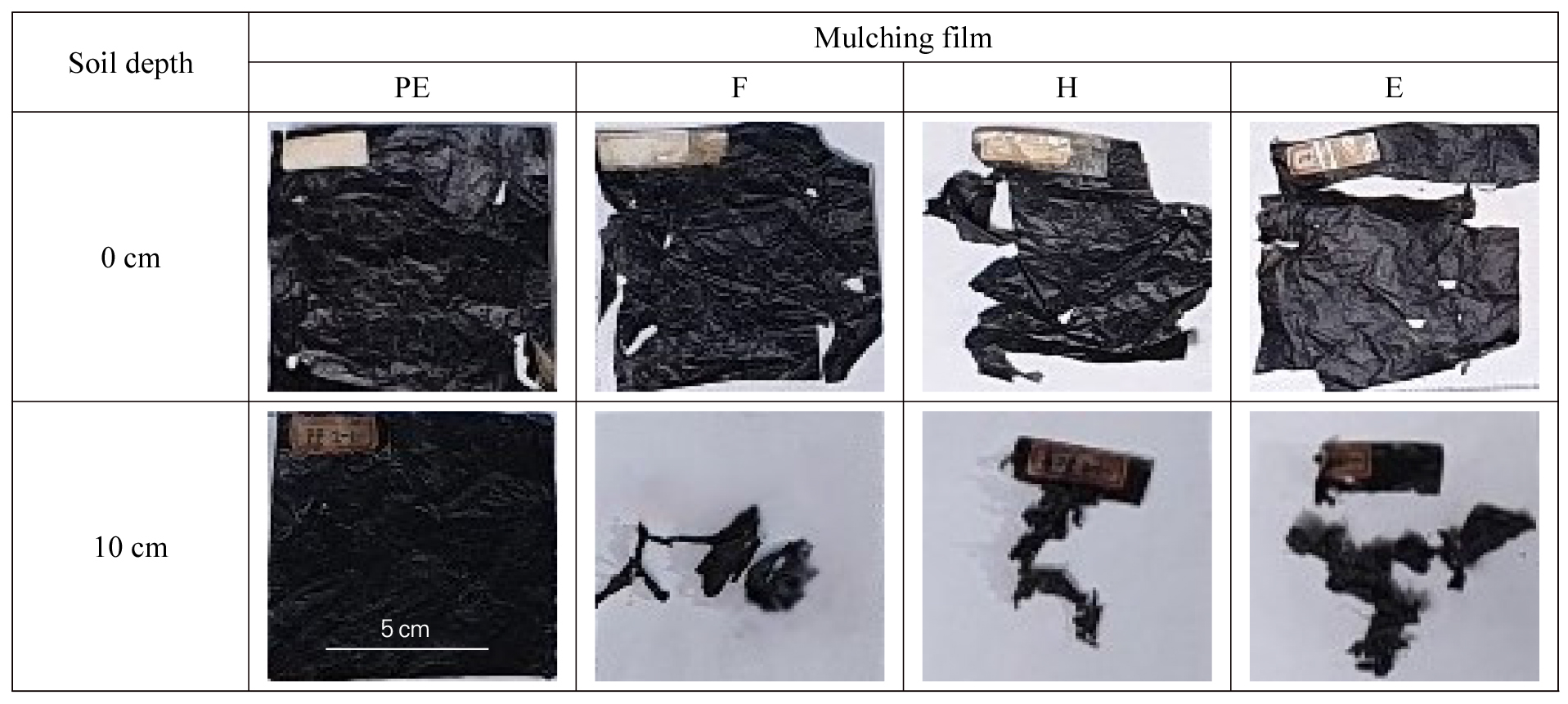
- Effects of Biodegradable-Film Mulch and Residue on the Growth and Yield of Pepper and Onion Cultivated under a Two-year Crop Rotation Scheme
- Do-Won Park, Hyun-Sug Choi
- This study was conducted to evaluate the effects of biodegradable (BD) films mulched in crop rotation fields, specifically pepper from April to …
- This study was conducted to evaluate the effects of biodegradable (BD) films mulched in crop rotation fields, specifically pepper from April to September and onion from October to May, as well as the effects of the film residue on soil mineral nutrition and crop growth outcomes in South Korea. Five treatments were used: non-mulching (NM), polyethylene (PE) film mulch, and three BD film mulches (referred to as F, H, and E). Film F was made using polybutylene adipate-co-terephthalate (PBAT) and polylactic acid (PLA); film H was made using PBAT+PLA; and film E was made using PLA+starch. The pepper field showed greater levels of degradation of all BD films, in particular for the H and F films, compared to the films in the onion field under exposure to excessively warm temperatures and high rainfall amounts during the cultivation period. The F film-mulched pepper plots had the lowest soil moisture level of ‒47.0 kpa on August 1, 2023 owing to high biodegradability, and the values for the onion plots remarkably in April of 2024. Seasonal soil electrical conductivity decreased in both the pepper and onion plots, with significantly higher levels in the mulch plots than in the NM plots in the pepper field at 0 and 30 days after transplanting (DAT). In most cases, no significant differences were observed in the soil mineral nutrient levels between the treated pepper and onion plots. The stem height increased in peppers grown under PE film mulching at 60 DAT and under F film mulching at 120 DAT. The number of pepper leaves increased with the BD mulching treatments at 60 and 90 DAT, with higher SPAD readings observed at 60 DAT. The greatest stem diameter and leaf fresh weight values were observed at 180 DAT in the E film-mulched onions. All mulch treatments increased the number of pepper fruits. The H film mulching treatment produced a large number of bulbs and resulted in the highest yield of 61.1 ton ha-1, followed by mulching with the E (59.4 ton), PE (48.5 ton), F (43.3 ton), and NM (34.0 ton) films. Breakdown of BD films, particularly the F film, occurred on topsoil with considerable disintegration at a depth of 10 cm in the onion field after the completion of one crop rotation cycle. Adverse effects from the remaining BD residue were not observed for the subsequent period of onion growth, and the H and E films were recommended to preserve soil health and improve crop productivity of warm- and cool-season vegetables. - COLLAPSE
-
Research Article
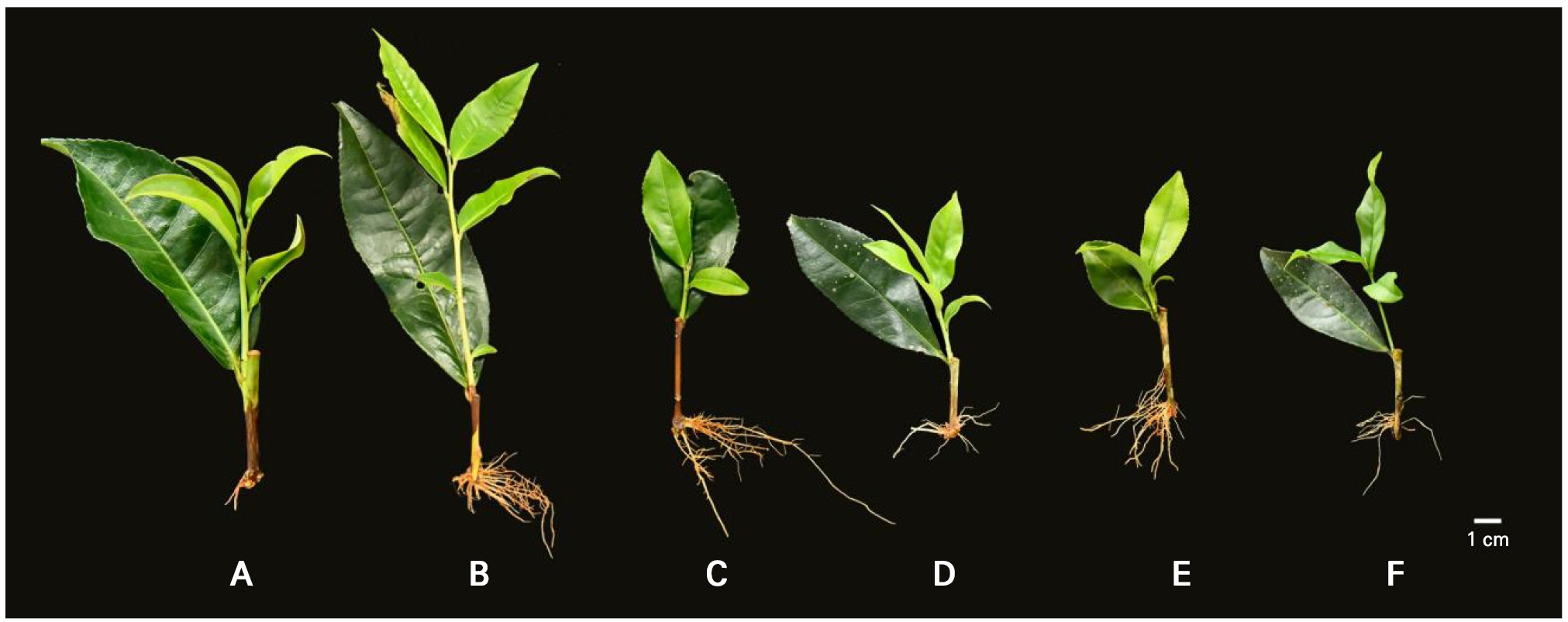
- Rooting Efficiency in Tea Plant Varieties: Physiological and Biochemical Determinants
- Yingyi Zhou, Zhongcheng Lu, Dafei Li, Huaisheng Zhou, Shi Tang, Wenting Zhang, Guanghui Wang, Dongliang Li
- This study investigated physiological and biochemical changes during the cutting propagation process in different tea plant varieties and the effects of these …
- This study investigated physiological and biochemical changes during the cutting propagation process in different tea plant varieties and the effects of these changes on the rooting efficiency. Dynamic changes in soluble sugars, soluble proteins, polyphenol oxidase (PPO), peroxidase (POD), indole-3-acetic acid oxidase (IAAO), endogenous hormones (indole-3-acetic acid (IAA), cytokinins (CTK), and abscisic acid (ABA)) were monitored and analyzed during the cutting propagation process of six tea plant varieties: ‘Hainan Dayezhong’ (HD), ‘Yunnan Dayezhong’ (YD), ‘Fuan Dabai’ (FA), ‘Fuding Dabai’ (FD), ‘Jinxuan’ (JX), and ‘Huang Guanyin’ (HG), which have varying rooting abilities. The study revealed significant differences among the varieties in terms of the rooting time and rooting ability. JX demonstrated the highest rooting rate and fastest rooting process, with 86.3% of cuttings rooting successfully, while HD exhibited the lowest rooting rate, with only 22.86% of cuttings rooting successfully. Varieties with high rooting rates showed higher soluble sugar contents at the initial rooting stage, a significant early increase in PPO and POD activities followed by a decline, and reduced IAAO activity levels during the induction and development stages of adventitious root (AR) formation. Higher IAA/CTK and IAA/ABA ratios were generally associated with increased rooting rates. Medium-leaved varieties exhibited higher root formation rates overall, especially JX and FD. Our study shows that during the critical period of AR formation, several key physiological and biochemical changes determine differences in rooting ability among tea plant varieties. An increase in the IAA content was crucial for inducing root primordia in varieties with high rooting rates. Additionally, a decrease in the IAAO activity, elevated POD and PPO activities, and the rapid accumulation of soluble sugars and proteins were closely related to successful rooting. In contrast, low-rooting varieties exhibited less pronounced changes in these parameters, potentially explaining their lower rooting efficiency. - COLLAPSE
-
Research Article
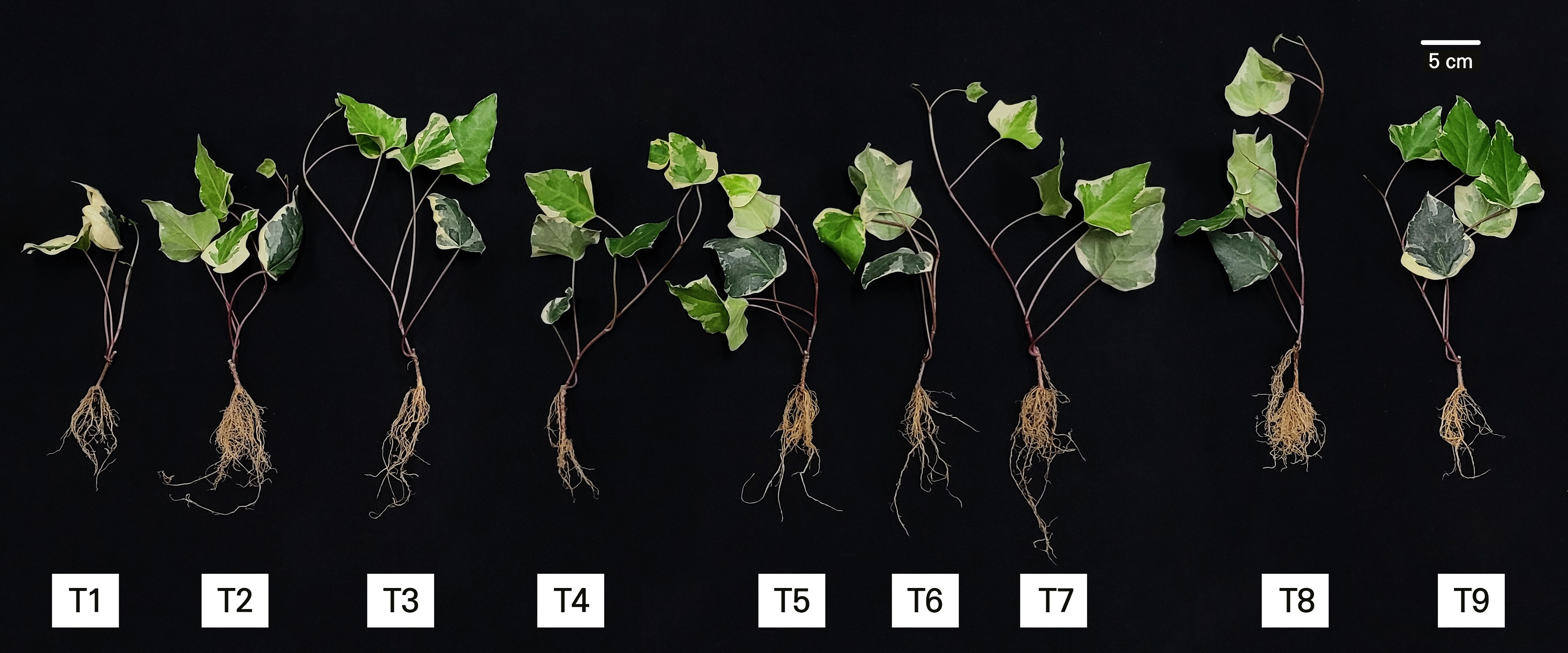
- Optimized Concentrations of Auxinic Rooting Promoters Improve Stem Cutting Propagation Efficiency and Morphophysiological Characteristics in Hedera algeriensis cv. Gloire de Marengo
- Jae Hwan Lee, Samuel Lee, Sang Yong Nam
- This study aimed to improve the stem-cutting propagation efficiency and morphophysiological characteristics of the variegated ornamental foliage plant Hedera algeriensis cv. Gloire …
- This study aimed to improve the stem-cutting propagation efficiency and morphophysiological characteristics of the variegated ornamental foliage plant Hedera algeriensis cv. Gloire de Marengo using two types of auxins and four concentrations for each type of auxinic rooting promoter tested here. The following nine concentrations were used: control; 3-indolebutyric acid (IBA) at 250, 500, 750, and 1000 mg·L-1; and 1-naphthylacetic acid (NAA) at 250, 500, 750, and 1000 mg·L-1. Plant size parameters varied with the auxinic rooting promoter concentrations, with IBA and NAA producing larger plants relative to the control. Shoot dry weight was highest at both IBA 500 mg·L-1 and NAA 500 mg·L-1, whereas root dry weight was significantly higher across all treatments compared to the control. Total dry weight followed patterns similar to the shoot dry weight. The moisture content showed no significant differences among the treatments. The Dickson quality index (DQI) was higher in all treatments except for the control, indicating improved plant quality with auxinic rooting promoters. The normalized difference vegetation index (NDVI) and maximum quantum yield (Fv/Fm) were highest at IBA 500 mg·L-1 and NAA 500 and 750 mg·L-1, indicating superior physiological responses in these treatments. The modified chlorophyll absorption ratio index (MCARI) was highest in the control treatment, while the photosynthetic performance index (PIABS) was highest in the NAA 500 mg·L-1 treatment, suggesting a lower chlorophyll content in the control and enhanced photosynthetic apparatus integrity due to the NAA 500 mg·L-1 treatment, respectively. In conclusion, NAA 500 mg·L-1 was the most effective concentration for ‘Gloire de Marengo’ stem-cutting propagation, followed by IBA 500 mg·L-1. These findings provide valuable insights into optimizing auxinic rooting promoter concentrations, offering crucial guidance for improving propagation efficiency and morphophysiological characteristics of this cultivar. - COLLAPSE
-
Research Article
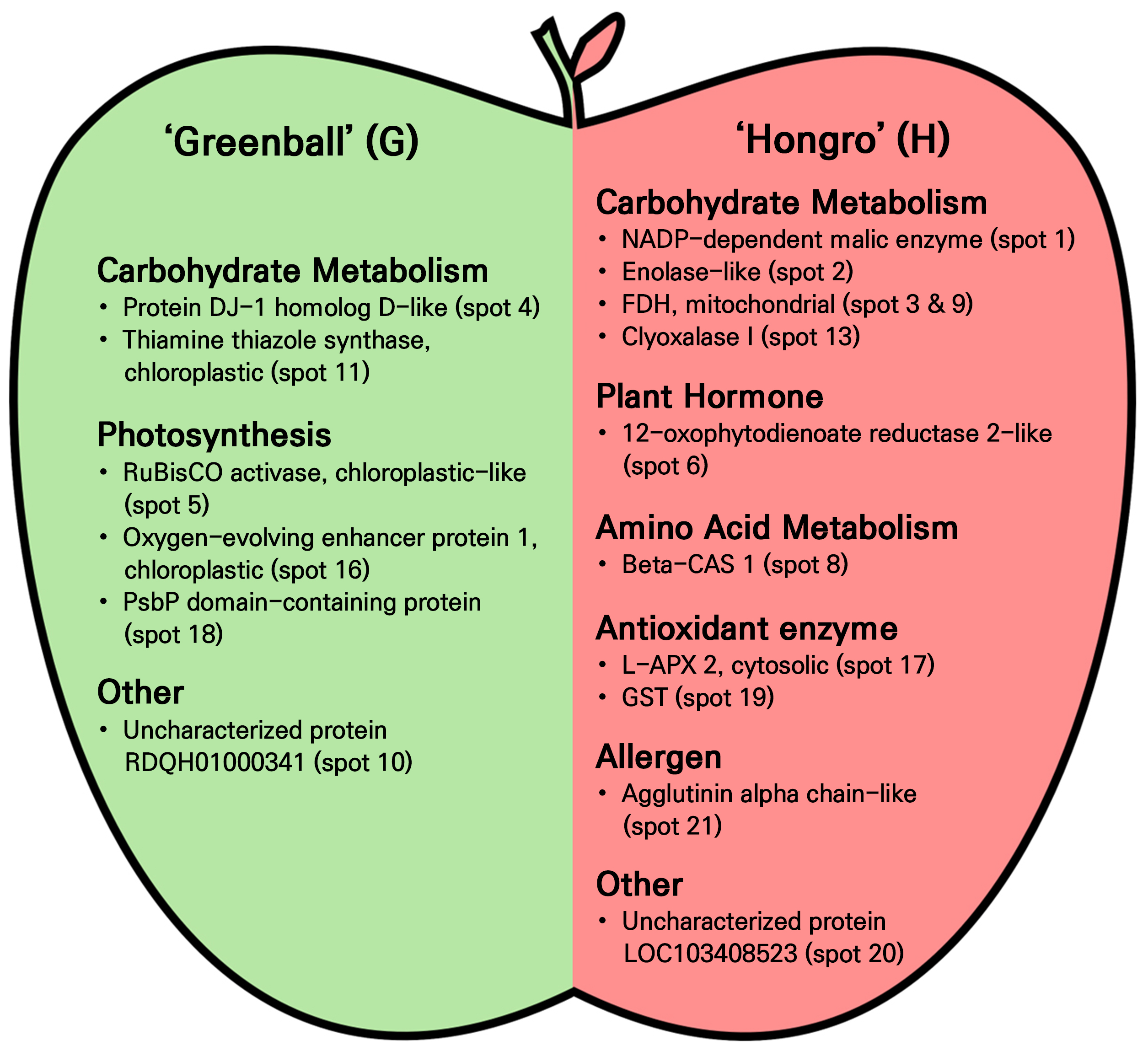
- Proteome Differences Expressed in the Peel of ‘Hongro’ and ‘Greenball’ Apples
- Sung Hwan Choi, Ho Yong Shin, Jae Ho Kim, Yun-Hee Kim, Jin Gook Kim, Jung-Sung Chung, Jeong Jin Hong, Eun Ho Jeong, Kyunghee Lee, Eun-Sil Chang, Young-Geol Sohn, Jeung Joo Lee
- The peel colors of ‘Hongro’ and ‘Greenball’, apple cultivars bred and cultivated in Korea, were deep red and greenish yellow, respectively, at …
- The peel colors of ‘Hongro’ and ‘Greenball’, apple cultivars bred and cultivated in Korea, were deep red and greenish yellow, respectively, at the time of harvest. ‘Hongro’ had more peel redness than ‘Greenball’, while ‘Greenball’ had more peel yellowness (b value) than ‘Hongro’. As a result of separating proteins extracted from the peels of the two apple cultivars by means of two-dimensional electrophoresis (2-DE), 17 protein spots in ‘Hongro’ and 12 in ‘Greenball’ exhibited expression rates more than twice those in the other cultivar. Through a matrix-assisted laser desorption/ionization time-of-flight/time-of-flight mass (MALDI-TOF/TOF) analysis, ten spots in ‘Hongro’ and five spots in ‘Greenball’ were identified as proteins with specific physiological functions. In’ Hongro’, the following proteins were expressed at higher levels than in ‘Greenball’: NADP-dependent malic enzyme (spot 1), enolase-like (spot 2), formate dehydrogenase, mitochondrial (spots 3 and 9) and glyoxalase Ⅰ (spot 13) involved in carbohydrate metabolism; 12-oxophytodienoate reductase 2-like (spot 6) catalyzing the biosynthesis of JA, a type of plant hormone; β-(cyanoalanine synthase) CAS 1 (spot 8) involved in amino acid metabolism; L-ascorbate peroxidase (AP) 2, cytosolic (spot 17) and glutathione S-transferase (GST)-like (spot 19), a type of antioxidant enzyme; and agglutinin alpha chain-like (spot 21), an allergen. In ‘Greenball’, the following proteins were expressed at higher levels than in ‘Hongro’: DJ-1 homolog D-like (spot 4) and thiamine thiazole synthase, chloroplastic (spot 11), which are involved in carbohydrate metabolism; ribulose-1,5-bisphosphate carboxylase/oxygenase (RuBisCO) activase, chloroplastic-like (spot 5), oxygen-evolving enhancer protein 1, chloroplastic (spot 16), and PsbP domain (PPD)-containing protein (spot 18), all of which are involved in photosynthesis. Meanwhile, among the proteins whose expression rates differed between ‘Hongro and ‘Greenball’, no proteins directly related to the development of peel color were identified. Additionally, seven proteins in ‘Hongro’ and seven in ‘Greenball’ were identified as unidentified or uncharacterized proteins. These results can be used for a wide range of studies related to the sensory quality, characteristics, production, and preservation of apples and can also serve as basic data for improving target traits in the breeding of new varieties. - COLLAPSE
-
Research Article
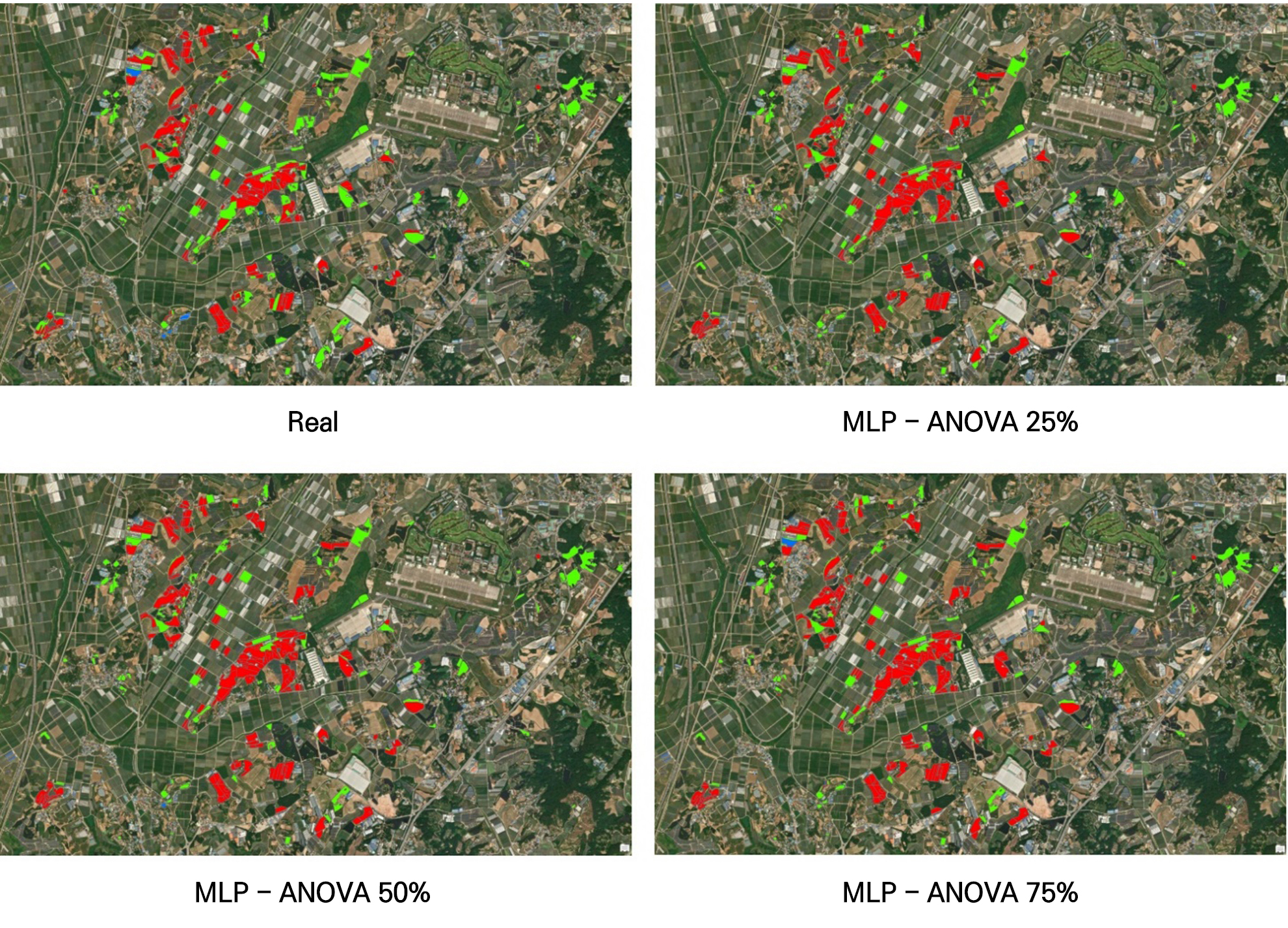
-
Spectral Index Derivation Based on Multi-Spectral Satellite Imagery for Apple and Pear Crop Classification
다분광 인공위성 영상 기반 분광 지표 도출에 따른 사과, 배 작목 분류
-
Hae Chan Jeon, Byeong Heon Min, Seung Wook Song, Jung Gun Cho, Il Ryong Kweon
전해찬, 민병헌, 송승욱, 조정건, 권일룡
- In the agricultural sector, crop classification serves as a crucial indicator for evaluating the adaptability of crops influenced according to factors such …
농업 분야에서 작목 분류는 기후, 토양 환경, 고도 조건 등 요인들에 영향을 받는 작목의 적응성을 평가하기 위한 중요한 지표로 활용한다. 이러한 차원에서 …
- In the agricultural sector, crop classification serves as a crucial indicator for evaluating the adaptability of crops influenced according to factors such as climate, soil conditions, and altitude. In this context, this study aims to analyze the accuracy of crop classification models based on spectral index extraction methods using multi-spectral satellite imagery for apple and pear crops. For this purpose, multi-spectral images were acquired for Nonsan city in Chungcheongnam-do, and apple and pear crops were classified according to the main spectral index extraction methods. The results showed that a machine learning algorithm, support vector machine (SVM), yielded higher accuracy when using the top 50% of the spectral indices (R2 = 0.7487) compared to the use of all spectral indices. Additionally, a deep learning model, multi-layer perceptron (MLP), showed relatively little variation in accuracy based on the spectral index extraction method (R2 = 0.8902). Therefore, the findings of this study present an efficient and scientific spectral index extraction method for classifying various crops, including apples and pears, across a wide range.
- COLLAPSE
농업 분야에서 작목 분류는 기후, 토양 환경, 고도 조건 등 요인들에 영향을 받는 작목의 적응성을 평가하기 위한 중요한 지표로 활용한다. 이러한 차원에서 이 연구는 다분광 인공위성 영상을 활용하여 사과, 배 작목의 주요 분광 지표 도출 방안에 따른 작목 분류 모델의 정확도를 분석하는 데 목적이 있다. 이를 위해, 충청남도 논산시를 대상으로 다분광 영상을 취득하고 주요 분광 지표 도출 방안에 따라 사과, 배 작목을 분류하였다. 그 결과, 기계학습 알고리즘인 서포트 벡터 머신(Support Vector Machine, SVM)은 모든 분광 지표를 사용할 때 보다 상위 50%의 분광 지표를 사용했을 경우 정확도가 높게 도출되었다(R2 = 0.7487). 또한, 딥러닝 모델인 다층 퍼셉트론(Multi-Layer Perceptron, MLP)의 경우, 분광 지표 도출 방안에 따른 정확도의 차이가 상대적으로 적었다(R2 = 0.8902). 따라서, 이 연구 결과는 광범위한 영역에서 사과와 배를 포함한 다양한 작목을 효율적이고 과학적으로 분류할 수 있는 분광 지표 도출 방안을 제시한다.
-
Spectral Index Derivation Based on Multi-Spectral Satellite Imagery for Apple and Pear Crop Classification
-
Research Article
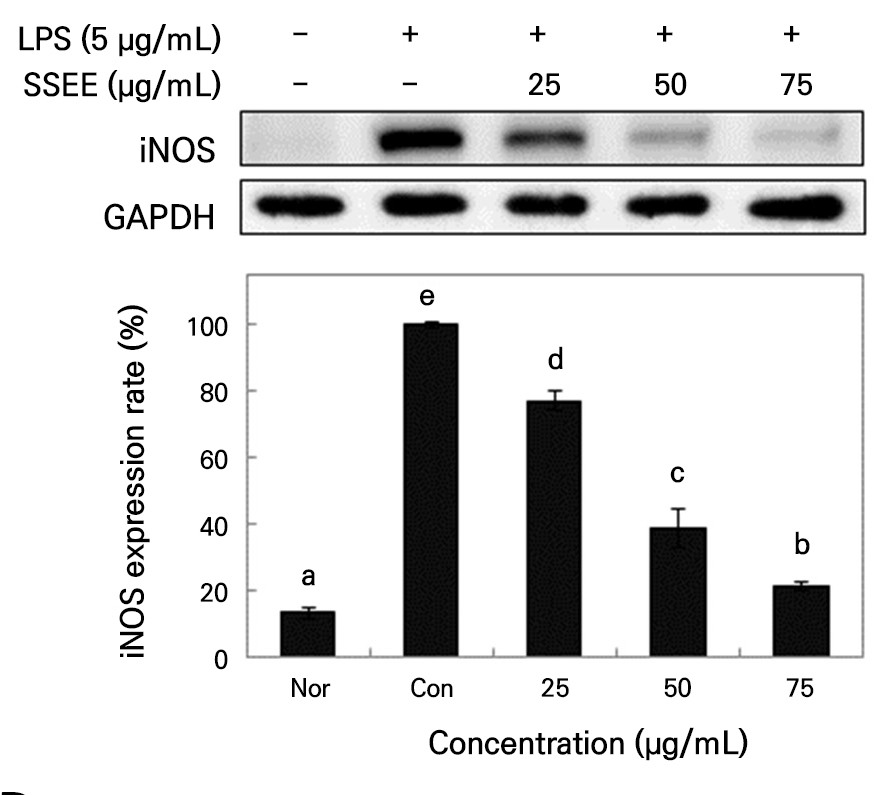
-
Anti-inflammatory Effect of Isolated Phenolics from Sambucus sieboldiana var. pendula Leaves on Raw 264.7 Cells with Stimulated Lipopolysaccharide
울릉도 자생 말오줌나무(Sambucus sieboldiana var. pendula) 잎으로부터 분리한 페놀성 물질이 LPS로 자극한 Raw 264.7 cell에서 나타내는 항염증 효과
-
Junhyo Cho, Hye-Jin Park, Jingi Yoo, In-Kyu Kang, Young-Je Cho
조준효, 박혜진, 유진기, 강인규, 조영제
- Phenolic compounds are well known to be among the major bioactive compounds found in various plant sources. It has been reported that …
본 연구에서는 말오줌나무잎 phenolics이 염증반응에 대해 나타내는 억제효과를 확인하였다. 항염증 효과를 확인하기 위해 Raw 264.7 대식세포에서 염증을 유발하는 LPS를 처리한 후 말오줌나무잎 …
- Phenolic compounds are well known to be among the major bioactive compounds found in various plant sources. It has been reported that Sambucus sieboldiana, found on Ulleung Island in Korea, contains phenolic compounds, suggesting potential health benefits. Thus, in this study, we determined the inflammatory activity of Sambucus sieboldiana with Raw 264.7 mouse macrophage cells. Phenolic compounds isolated from Sambucus sieboldiana were exposed to LPS-stimulated macrophages to determine whether an anti-inflammatory effect existed. The inflammation-associated protein expression, activity, and gene expression levels were measured by means of ELISA, a western blot analysis, and qPCR. Phenolic compounds from Sambucus sieboldiana inhibited the expression of iNOS, COX-2, and their downstream products PGE2 and NO, which are part of the NF-kB signaling pathway. The mRNA gene expression levels of pro-inflammatory cytokines, in this case TNFα, IL1β, IL6, MCP1, and PTGES2, were significantly decreased. These results showed that phenolic compounds from Sambucus sieboldiana have an anti-inflammatory effect, suggesting that Sambucus sieboldiana can potentially be used as an anti-inflammatory treatment, such as therapeutic and/or cosmetic products for the skin, particularly for skin inflammation. However, further in vivo studies using phenolics from Sambucus sieboldiana are needed to support the current findings.
- COLLAPSE
본 연구에서는 말오줌나무잎 phenolics이 염증반응에 대해 나타내는 억제효과를 확인하였다. 항염증 효과를 확인하기 위해 Raw 264.7 대식세포에서 염증을 유발하는 LPS를 처리한 후 말오줌나무잎 phenolics이 염증 관련 인자 생성을 억제하는 효과를 ELISA, western blotting과 real-time PCR을 사용하여 측정한 결과, 말오줌나무잎 phenolics에 의해 염증인자인 NO 생성이 억제되었고, iNOS, COX-2 단백질 발현량이 억제되었으며, pro-inflammatory cytokine인 TNFα, IL1β, IL6, MCP1, PTGES2 등의 mRNA 발현이 유의적으로 억제되는 경향을 나타내었다. 따라서 말오줌나무잎 phenolics은 염증 발생에서 NF-κB의 신호전달에 의해 발현이 조절되는 iNOS, COX-2 protein의 발현억제와 염증반응에 관여하는 cytokine을 생산하는 TNFα, IL1β, IL6, MCP1, PTGES2 등의 mRNA 발현을 억제하여 높은 항염증효과를 나타내는 것을 확인할 수 있었다.
-
Anti-inflammatory Effect of Isolated Phenolics from Sambucus sieboldiana var. pendula Leaves on Raw 264.7 Cells with Stimulated Lipopolysaccharide


 Horticultural Science and Technology
Horticultural Science and Technology










